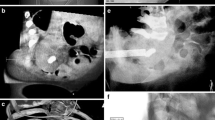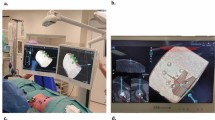Abstract
Purpose
To evaluate the feasibility of flat detector cone beam computed tomography (CBCT)-guided nephrostomy using virtual navigation in patients with iatrogenic ureteral injury.
Materials and methods
A retrospective review of percutaneous nephrostomy (PN) revealed the use of CBCT with 3D virtual navigation guidance in 42 procedures (40 patients) for patients with iatrogenic ureteral injury. All procedures were shown as second-line interventions after failed ultrasound-guided nephrostomy. Data on technical success rate, procedure time, puncture performance, radiation exposure, complications, and clinical success were collected.
Results
The technical success rate was 95.2% (40/42). The mean puncture performance score was 4.4 ± 1.0, and the procedure time was 25.2 ± 3.1 min, resulting in a mean effective exposure dose of 5.9 ± 2.3 mSv. There were no serious complications. During the mean follow-up periods of 11.4 months (range 6–19), clinical success rates following drainage were 72.5% (29/40), and ten cases (25%) had secondary surgical treatments.
Conclusion
CBCT with 3D virtual navigation is a feasible technique for PN with reasonable exposure dose and can serve as a second-line intervention after failed ultrasound guidance.


Similar content being viewed by others
References
Zinman LN, Vanni AJ (2016) Surgical management of urologic trauma and iatrogenic injuries. Surg Clin North Am 96:425–439
Chung D, Briggs J, Turney BW et al (2016) Management of iatrogenic ureteric injury with retrograde ureteric stenting: an analysis of factors affecting technical success and long-term outcome. Acta Radiol 23:0284185116638568 (Epub ahead of print)
Egilmez H, Oztoprak I, Atalar M et al (2007) The place of computed tomography as a guidance modality in percutaneous nephrostomy: analysis of a 10-year single center experience. Acta Radiol 48:806–813
Durrani SN, ur Rehman A, Khan s et al (2013) Ureteral trauma during open surgery: aetiology, presentation and management. J Ayub Med Coll Abbottabad 25:86–89
Montvilas P, Solvig J, Johansen TE (2011) Single-centre review of radiologically guided percutaneous nephrostomy using “mixed” technique: success and complication rates. Eur J Radiol 80:553–558
Floridi C, Muollo A, Fontana F et al (2014) C-arm cone-beam computed tomography needle path overlay for percutaneous biopsy of pulmonary nodules. Radiol Med 119:820–827
Jiao DC, Han XW, Wu G et al (2015) 3D CACT-assisted radiofrequency ablation following transarterial chemoembolization for hepatocellular carcinoma: early experience. Asian Pac J Cancer Prev 16:7897–7903
Jiao D, Yuan H, Zhang Q et al (2016) Flat detector C-arm CT-guided transthoracic needle biopsy of small (≤2.0 cm) pulmonary nodules: diagnostic accuracy and complication in 100 patients. Radiol Med 121:268–278
de la Rosette JJ, Opondo D, Daels FP et al (2012) Categorisation of complications and validation of the Clavien score for percutaneous nephrolithotomy. Eur Urol 62:246–255
Suzuki S, Furui S, Yamaguchi I et al (2009) Effective dose during abdominal three-dimensional imaging with a flat-panel detector angiography system. Radiology 250:545–550
Franklin A, Pokala N, Jones C et al (2016) Is the robotic approach feasible for repair of iatrogenic injuries of the lower ureter? World J Urol 34:1323–1328
Koukouras D, Ta Petsas, Liatsikos E et al (2010) Percutaneous minimally invasive management of iatrogenic ureteral injuries. J Endourol 24:1921–1927
Zilberman DE, Rimon U, Morag R et al (2015) Non-surgical treatment of latrogenic postoperatively diagnosed ureteral injuries. Isr Med Assoc J 17:227–230
Hegele A (2016) Renal and ureteral injuries. Diagnosis and treatment. Urologe A 55:460–465
Chen ML, Shukla G, Jackman SV et al (2011) Real-time tomographic reflection in facilitating percutaneous access to the renal collecting system. J Endourol 25:743–745
Song Y, Ma Y, Song Y et al (2015) Evaluating the learning curve for percutaneous nephrolithotomy under total ultrasound guidance. PLoS One 10:e0132986
Chi Q, Wang Y, Lu J et al (2014) Ultrasonography combined with fluoroscopy for percutaneous nephrolithotomy: an analysis based on seven years single center experiences. Urol J 11:1216–12166
Jiao D, Huang K, Wu G et al (2016) Flat detector cone-beam CT-guided percutaneous needle biopsy of mediastinal lesions: preliminary experience. Radiol Med 121:769–779
Floridi C, Radaelli A, Abi-Jaoudeh N et al (2014) C-arm cone-beam computed tomography in interventional oncology: technical aspects and clinical applications. Radiol Med 119:521–532
Jiao DC, Li ZM, Yuan HF et al (2016) Flat detector C-arm CT-guidance system in performing percutaneous transthoracic needle biopsy of small (≤3 cm) pulmonary lesions. Acta Radiol 57:677–683
Song Y, Ma Y, Song Y et al (2015) Evaluating the learning curve for percutaneous nephrolithotomy under total ultrasound guidance. PLoS One 10:e0132986
Roy OP, Angle JF, Jenkins AD et al (2012) Cone beam computed tomography for percutaneous nephrolithotomy: initial evaluation of a new technology. J Endourol 26:814–818
Hawkins CM, Kukreja K, Singewald T et al (2016) Use of cone-beam CT and live 3-D needle guidance to facilitate percutaneous nephrostomy and nephrolithotripsy access in children and adolescents. Pediatr Radiol 46:570–574
Ritter M, Rassweiler MC, Michel MS (2015) The Uro Dyna-CT enables three-dimensional planned laser-guided complex punctures. Eur Urol 68:880–884
Al-Awadi K, Kehinde EO, Al-Hunayan A et al (2005) Iatrogenic ureteric injuries: incidence, aetiological factors and the effect of early management on subsequent outcome. Int Urol Nephrol 37:235–241
Zilberman DE, Rimon U, Morag R et al (2015) Non-surgical treatment of latrogenic postoperatively diagnosed ureteral injuries. Isr Med Assoc J 17:227–230
Rais-Bahrami Soroush, Friedlander Justin I, Duty Brian D et al (2011) Difficulties with access in percutaneous renal surgery. Ther Adv Urol 3:59–68
Kyriazis I, Panagopoulos V, Kallidonis P et al (2015) Complications in percutaneous nephrolithotomy. World J Urol 33:1069–1077
Braak SJ, van Strijen MJ, van Es HW et al (2011) Effective dose during needle interventions: cone-beam CT guidance compared with conventional CT guidance. J Vasc Interv Radiol 22:455–461
Teeuwisse WM, Geleijns J, Broerse JJ et al (2001) Paitents and staff dose during CT guided biopsy, drainage and coagulation. Br J Radiol 74:720–726
Acknowledgements
This study was funded by The National High Tech Research and Development Program (863 Program) (Grant number: 2015AA020301).
Author information
Authors and Affiliations
Corresponding author
Ethics declarations
Conflict of interest
The authors declare that they have no conflict of interest.
Ethical standards
All procedures performed in studies involving human participants were in accordance with the ethical standards of the Institutional and/or National Research Committee and with the 1964 Helsinki declaration and its later amendments or comparable ethical standards.
Informed consent
Informed consent was obtained from all individual participants included in the study.
Rights and permissions
About this article
Cite this article
Jiao, D., Li, Z., Li, Z. et al. Flat detector cone beam CT-guided nephrostomy using virtual navigation in patients with iatrogenic ureteral injury. Radiol med 122, 557–563 (2017). https://doi.org/10.1007/s11547-017-0751-9
Received:
Accepted:
Published:
Issue Date:
DOI: https://doi.org/10.1007/s11547-017-0751-9




